Dwaeji galbijjim, or Korean soy braised pork ribs, is an easy and super flavorful braised dish featuring fall-off-the-bone tender pork ribs, potatoes, and carrots. Our recipe shares 2 ways to make dwaeji galibijjim, the traditional stovetop method and one using a pressure rice cooker.
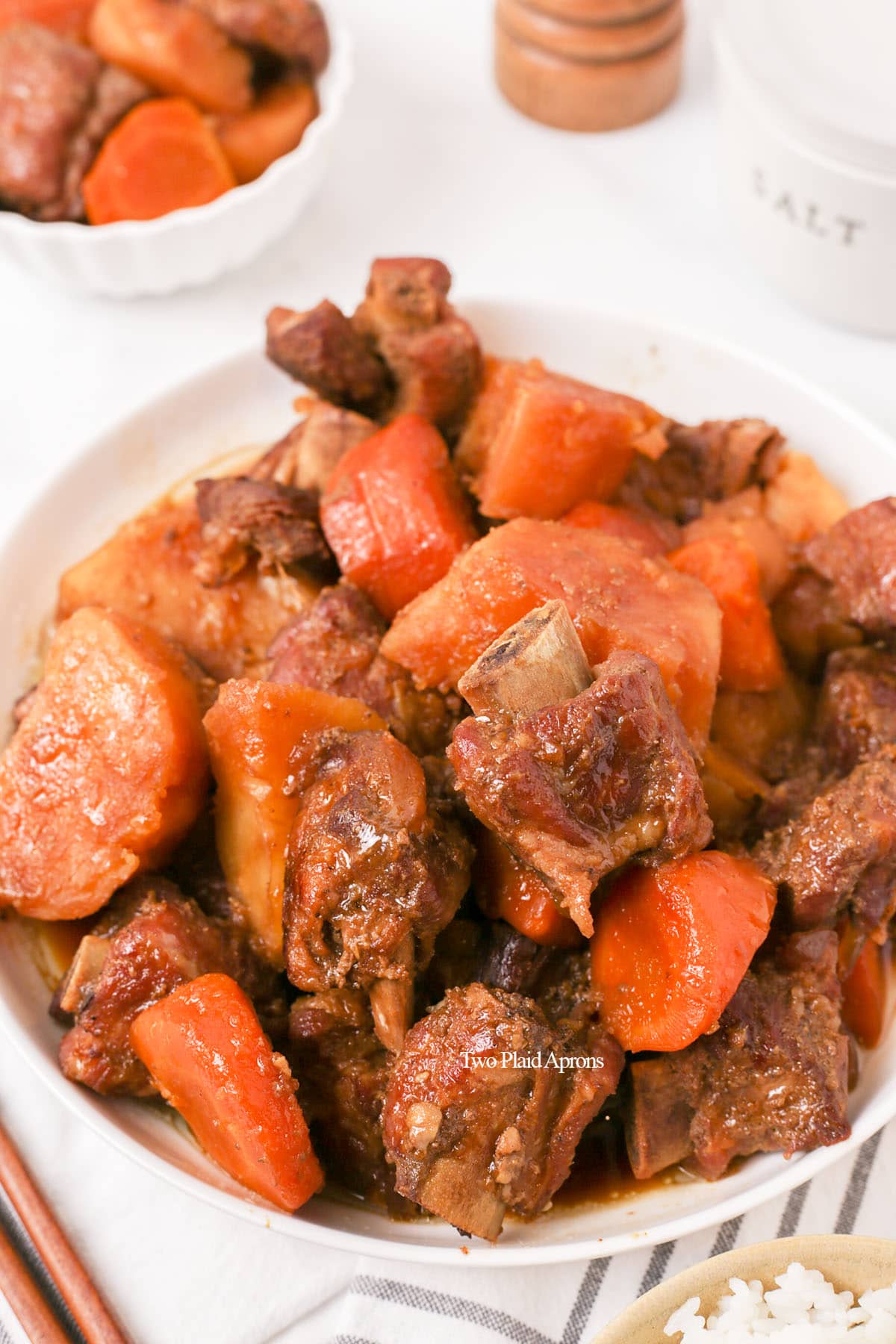
If you love soy braises, you'll love dwaeji galibjiim! It's perfectly balanced between sweet and savory with fall-off-the-bone tender ribs and flavorful potatoes and carrots that's soaked up all the yummy braising sauce.
We shared two ways to make this Korean braised pork ribs: stovetop method and pressure rice cooker method. The stovetop method is a classic way to make braises. It's no frills, just need some time and patience. But if you've got a pressure rice cooker like Cuckoo rice cooker, it will make this dwaeji galbijjim recipe extra simple and easy! Plus, it'll cook up in half the time and the ribs are guaranteed chopstick tender!

Jump to:
What to eat with Korean soy braised pork ribs
This dwaeji galbijjim is so flavor. You could eat it with anything! But here are some sides we recommend and love to eat with these braised pork ribs:
- Rice - This is a must! Gotta have some rice to soak up all the flavorful juices. Steamed white rice is a classic, but don't sleep on Korean purple rice! It's just as good.
- Gyeran jjim - Also known as Korean volcano steamed eggs. A classic side that's great with anything.
- Kimchi - The spiciness and tang helps to cut the richness from the braised ribs. Classic napa cabbage kimchi is always a great choice, but for something quick, try our cucumber kimchi (oi kimchi).
- Japchae (Korean glass noodle stir fry) - A classic side that could also be a main dish because it's so good! Always good with anything.

Ingredients and substitutions
Please scroll down to the recipe card for the ingredient quantities!
For the braised ribs:
- Pork riblets - We recommend pork riblets because they are usually already cut into pieces or cut into a long strips so you can easily cut it at home. If you prefer, you could also use pork spare ribs and request the butcher to cut it into 1 to 2 inch pieces.
- Russet potatoes - Great potatoes to soak up all the flavors in the sauce. You could use baby potatoes, gold potatoes, or any potatoes you prefer.
- Carrot - To add some color and sweetness to the braise.
- Onion - To add some onion flavor to the braise and some more sweetness.
- Green onion (optional for garnish)

For the marinade:
- Soy sauce - We highly recommend using regular sodium soy sauce, NOT low sodium. Low sodium soy sauce will make the braised ribs taste under seasoned.
- Brown sugar - To add sweetness, color, some caramelized flavor, and a depth of flavor. If you don't have brown sugar, regular granulated sugar is okay.
- Shaoxing rice wine - Some rice cooking wine helps to get rid of some unwanted porky flavors from the ribs and to make the braise more fragrant.
- Apple - Adds natural sweetness to the marinade, but most importantly, the apple helps to tenderize the pork ribs. We recommend juicy apples like Fuiji. If you prefer, you could use Korean pears instead.
- Garlic and ginger - These will flavor the braise and make the braise more fragrant.
- Black pepper - Just a little add some peppery notes to the braise.
How to make Korean braised pork ribs
Marinate the ribs:
1. Combine all of the marinade ingredients into a food processor and blend until evenly combine and mostly smooth.

2. Pour the marinade into a large mixing bowl along with the pork ribs. Mix until the ribs are well coated with the marinade. Cover and set aside to marinate for at least 1 hour, preferably overnight for best flavor.


🌟 Pro tip: Wash and rinse the ribs a couple of times before marinating to get rid of any excess blood or bone fragments that came from cutting the ribs.

Cuckoo rice cooker method:
1. Transfer the marinated ribs and the marinade into the rice cooker pot. Scatter the cut potato, carrots, and onion on top of the ribs.
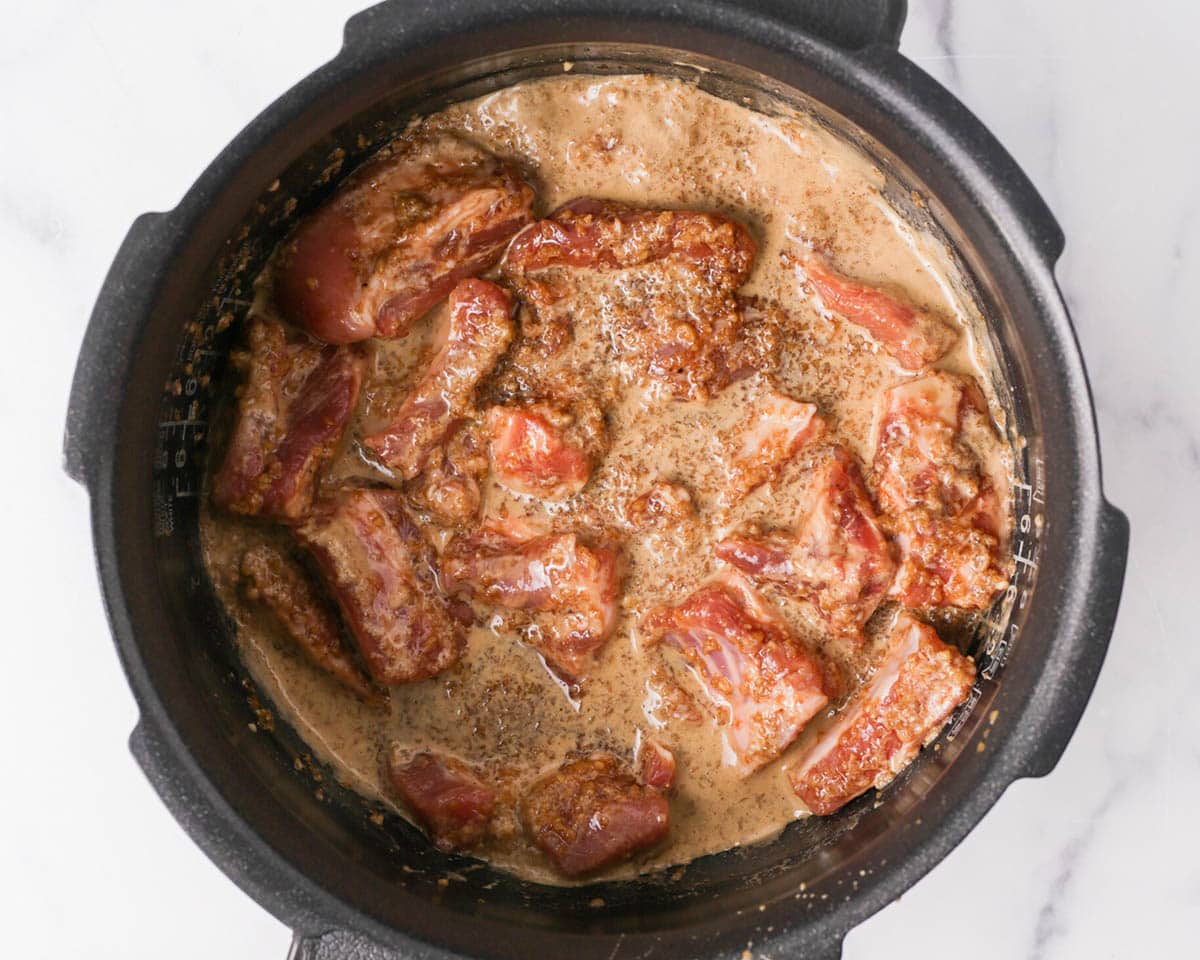

2. Secure and lock the rice cooker lid and set the rice cooker to the multicook setting for 35 minutes.
3. Once the cook time is up, carefully remove the pot and garnish with green onions. Serve the galbijjim hot with steamed rice.
Stovetop method:
1. Transfer the marinated ribs into a tall pan or medium pot. Scatter the potato, carrots, and onions evenly over the ribs.


2. Bring the ribs to a boil, then reduce the heat to keep the ribs at a constant simmer. Cover the pan or pot with a lid and let the ribs simmer for about 45 minutes to 1 hour, or until the ribs are tender and the vegetables are cooked. Stir the pot occasionally.
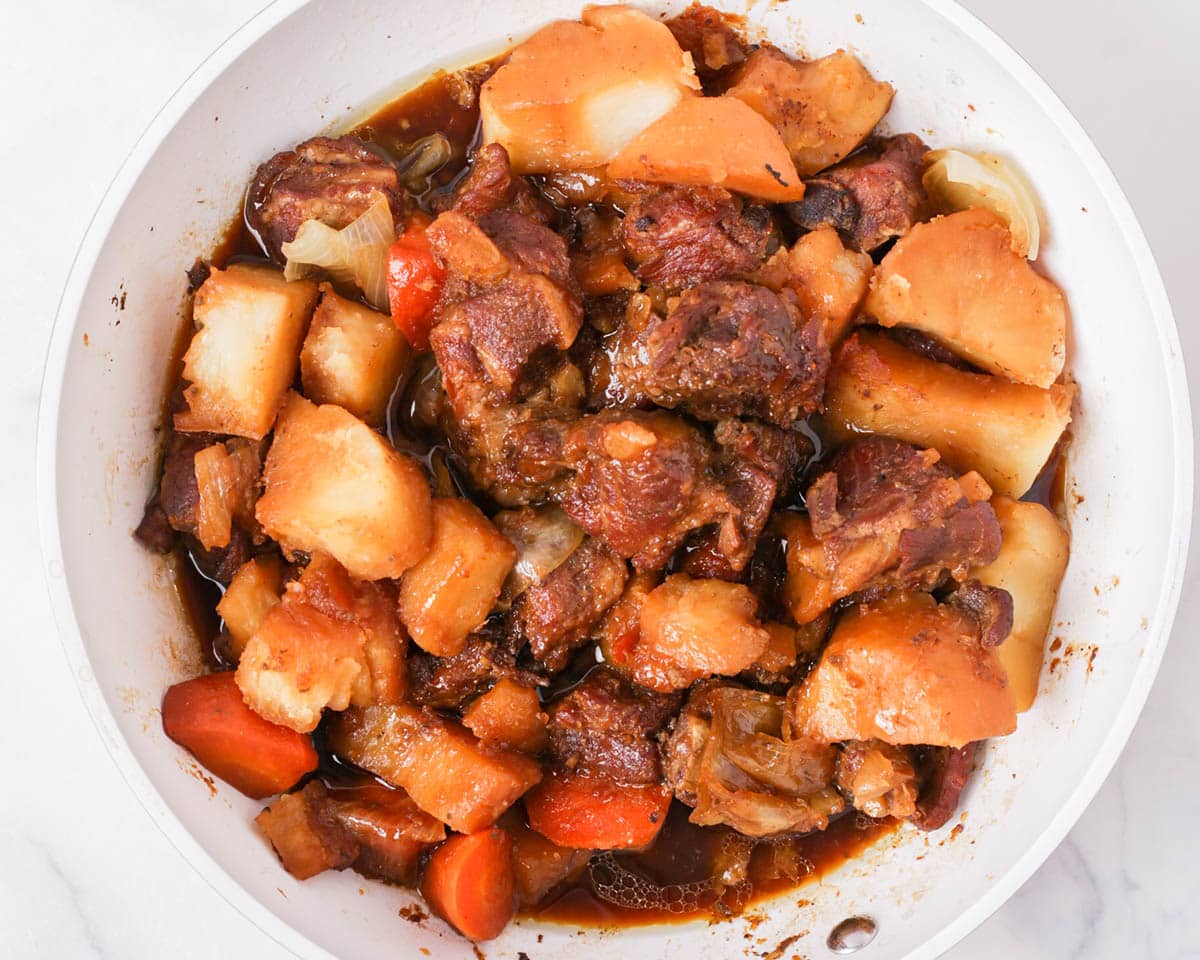
3. If you prefer your braising liquid to be more concentrated, remove the lid at the last 10 minutes of cooking and let the sauce simmer until desired thickness.
4. When the ribs are done cooking, remove from the pan and garnish with green onions. Enjoy with fresh steamed rice!

Recipe tips
- Marinate the pork ribs overnight for best result and flavor.
- Cut the potatoes into large chunks so that they are perfectly cooked by the time the ribs are tender. We recommend cutting the potato in half, lengthwise. Then, cut it into at least 1 inch thick half moons.
- If using pork spare ribs, ask your butcher to cut the ribs into 1 ½ inch to 2 inch pieces. The ribs will marinate better and will be easier to eat.
Storage and reheating
Leftover dwaeji galbijjim can be stored in the fridge for up to 4 to 5 days, or frozen for up to 2 months. Just make sure to let the braised pork ribs cook completely before storing in airtight containers. If freezing, we recommend pre-portioning the ribs, so that you can thaw as much as you need.
To reheat, simply microwave in a microwave safe container until hot. You can also reheat it on the stovetop in a pan or pot until hot. If the pork ribs are frozen, we recommend thawing it overnight before reheating.

FAQ
Yes! Feel free to substitute the veggies for your preferred ones. Although, we do recommend having potatoes because they taste amazing in a soy braise.
If your ribs are dry, it's most likely because the heat was too high. Make sure to keep your ribs at a constant, medium simmer after bring it to a boil. Boiling it will dry out the ribs.
Yes. You can use any pressure rice cooker or regular pressure cookers to make this Korean braised pork ribs. However, the cook time and method in our recipe is based on our Cuckoo rice cooker, which may require a different cook time and method than yours.
If you’ve made this recipe or any recipes from our blog, please tag us on Instagram using #twoplaidaprons! You can also tag us in your Instagram stories using @two_plaid_aprons. We would love to see your creations! It absolutely makes our day! 🥰
📖 Recipe
Dwaeji Galbijjim (Korean Braised Pork Ribs)
Ingredients
For the braised pork ribs:
- 2 pounds pork riblets or spare ribs cut into 1½ to 2 inches pieces
- 2 medium russet potato peeled and cut into 2 inch chunks
- 1 large carrot peeled and cut into 1 inch chunks
- 1 large yellow onion peeled and cut into large pieces
- Green onions thinly sliced (optional for garnish)
- Cooked white rice (for serving)
For the marinade:
- ½ cup regular soy sauce
- ¼ cup dark brown sugar packed
- 2 tablespoons Shaoxing rice wine
- ½ large apple cored, peeled, and cut into smaller chunks (preferably Fuji apples)
- 2 cloves garlic
- 1 inch knob of ginger peeled and cut into smaller pieces
- Few cracks of black pepper
Instructions
Marinate the pork ribs:
- Combine all of the marinade ingredients into a food processor and blend until evenly combine and mostly smooth.
- Pour the marinade into a large mixing bowl along with the pork ribs. Mix until the ribs are well coated with the marinade. Cover and set aside to marinate for at least 1 hour, preferably overnight. Pro tip: Wash and rinse the ribs a couple of times before marinating to get rid of any excess blood or bone fragments that came from cutting the ribs.
(Pressure) Rice cooker method:
- Transfer the marinated ribs and the marinade into the rice cooker pot. Scatter the cut potato, carrots, and onion on top of the ribs.
- Secure and lock the rice cooker lid and set the rice cooker to the multicook setting for 35 minutes.
- Once the cook time is up, carefully remove the pot and garnish with green onions. Serve the galbijjim hot with steamed rice.
Stove top method:
- Transfer the marinated ribs into a tall pan or medium pot. Scatter the potato, carrots, and onions evenly over the ribs.
- Bring the ribs to a boil, then reduce the heat to keep the ribs at a constant simmer. Cover the pan or pot with a lid and let the ribs simmer for about 45 minutes to 1 hour until the ribs are tender and the vegetables are cooked. Stir the pot occasionally.
- If you prefer your braising liquid to be thicker, remove the lid at the last 10 minutes of cooking and let the sauce simmer until desired consistency.
- When the ribs are done cooking, remove from the pan and garnish with green onions. Enjoy with fresh steamed rice!
Notes
- Rice cooker method - Our cooking time and method is based on Cuckoo Rice Cooker (CRP-JHR1009F). Other rice cookers may differ in cook time and methods.
- Soy sauce - We highly recommend using regular sodium soy sauce, NOT low sodium soy sauce, or the ribs will taste under-seasoned. If you only have low sodium soy sauce, we recommend compensating with some additional salt.











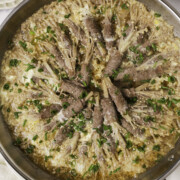







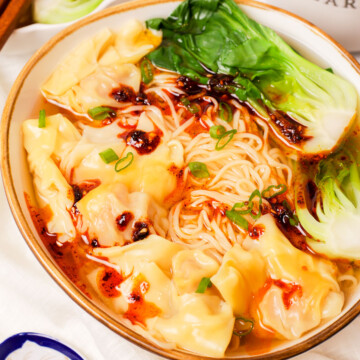
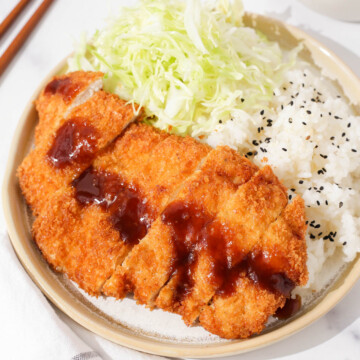

Comments
No Comments